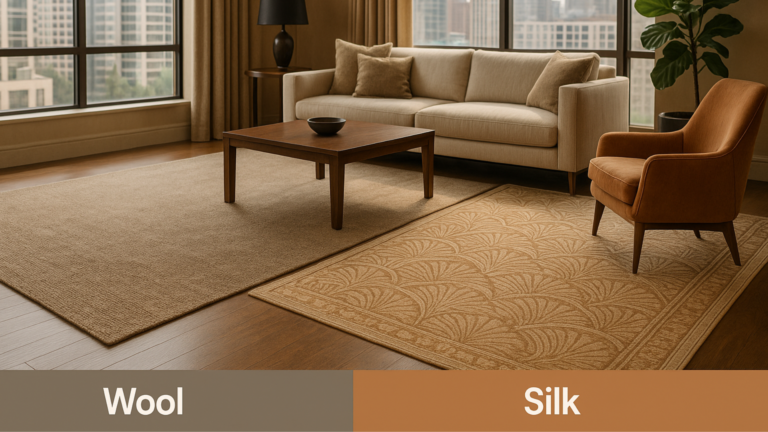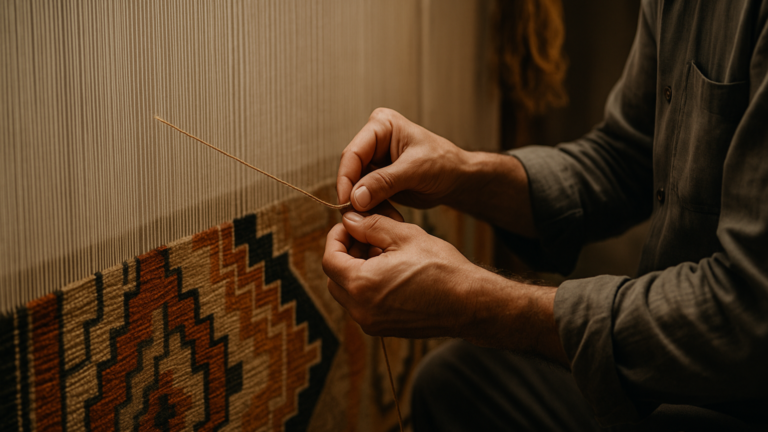
Kilim Rugs: A Look into Their Art, History, and Practical Use
Kilim rugs are a well-loved type of flat-woven rug with a long history. They are made using special weaving techniques and do not have the thick pile that many traditional carpets have. Kilim weaving developed in regions such as Turkey (including Anatolia and Thrace), Pakistan, Iran, Afghanistan, North Africa, Central Asia, China, the Balkans, and the Caucasus. These rugs carry cultural significance, creative expression, and everyday practicality.
In India, many people appreciate kilim rugs for their patterns, colors, and craft. As Indian homes combine modern and traditional styles, kilim rugs fit into many different interiors. They can be placed in living rooms, bedrooms, hallways, or even used as wall hangings. Because they do not have a pile, they are also easy to fold, store, or move around, making them versatile for every season or occasion.
Table of Contents
1. Ancient Roots of Kilim Rugs
Kilim rugs trace their origins back to ancient history. While some historians date them to the eighth and ninth centuries CE, it is possible that the technique is even older. Different communities across Asia, North Africa, and Eastern Europe have practiced similar weaving approaches for centuries. Kilims started as practical household items, such as coverings, floor spreads, and prayer mats.
Over time, kilims became more than just functional rugs. Weavers found ways to personalize them with symbols and colors that showed their emotions, beliefs, and identities. Each region developed specific designs and hues that came from local materials. For example, certain areas might favor red dyes from madder roots, while others might use a unique shade of blue from woad or indigo. The weaver’s hand, choice of dye, and local tradition all worked together to produce a one-of-a-kind piece.
In many families, kilim-making was often a skill passed down through generations. Young weavers learned the craft from parents or grandparents, ensuring that ancient methods stayed alive. For the people who made them, kilims became part of daily life—used for seating, bedding, or for ceremonial occasions. Some families created special kilims as part of dowries, symbolizing hope for prosperity in marriage.
2. Practical Importance and Cultural Significance
Kilims are not only used on floors but also in other parts of the home. Historically, these flat-woven textiles served as prayer rugs or seat covers. Some were hung on walls as decorative pieces, bringing color and pattern to the interiors. In many regions, kilims symbolized status or family heritage, and they were carefully stored and passed down as heirlooms.
Because kilims can be folded and carried easily, nomadic tribes found them very convenient. Groups that moved from place to place in search of grazing lands would pack kilims along with their belongings. These rugs offered warmth, privacy, and a way to personalize tents. Even in permanent homes, people used them as multifunctional textiles—on floors, on furniture, or even as makeshift curtains.
Kilim rugs also serve as a communication tool. Many weavers include symbols that represent emotions, natural events, or social status. Viewers might see stylized plants, animals, or geometric shapes that convey stories or beliefs. When someone knows how to interpret these symbols, they can learn about the weaver’s background, hopes, and dreams. This connection between the maker’s story and the rug itself makes kilims more than just decorative objects.
3. Materials and Dyes: The Heart of Authentic Kilims
One of the reasons kilim rugs attract so many enthusiasts is the care that goes into selecting and preparing materials. Weavers traditionally prefer wool for the warp and weft. Wool is durable, has excellent dye-absorption qualities, and is more comfortable underfoot than many synthetic fibers. In some kilims, goat hair or cotton is also used to provide strength or add visual interest.
Natural dyes are a key part of authentic kilims. These dyes come from roots, leaves, flowers, or even insects, and they produce rich colors that slowly develop a soft patina over time. While synthetic dyes are also used by modern weavers for convenience and a broader range of shades, many collectors prefer rugs made with natural dyes. They believe these shades age more gracefully, holding onto depth and character for decades.
When you look at a traditional kilim with natural dyes, you might notice minor variations in color, known as “abrash.” These variations are part of the rug’s character and proof that it was woven by hand. Abrash happens when dye lots differ slightly, or when the same dye is used at different times, each batch having its own shade. Rather than reducing the quality of a kilim, many experts see abrash as a sign that the rug is genuine and made with a personal touch.
4. Weaving Techniques That Shape Kilim Rugs
There are multiple techniques for flat-weaving rugs, but they all share the fact that no knots are used. Instead, the weaver interlaces the weft threads over and under the warp threads, alternating rows for sturdiness. When a new color is needed, the weaver switches weft threads, creating patterns and shapes. This method uses less raw material and takes less time than making a knotted pile rug, making kilims more affordable while still maintaining their artistic charm.
Some of the most common flat-weaving techniques include:
- Plain Weave (Weft-Faced Plain Weave): Here, the entire pattern shows up on the weft threads, with the warp threads hidden. The result is a smooth finish with blocks of color forming geometric shapes.
- Slit Weave: In this approach, weavers leave small openings or “slits” between blocks of color by turning the weft around the last warp in a color area. This creates sharp-edged designs and is often used for bold geometric patterns.
- Tapestry Weave: This method lets the weaver change colors at any point in a row, giving freedom to craft intricate patterns with curves and complex motifs. Because of the detail involved, tapestry weave can be more time-consuming.
- Soumak Weave: Soumak rugs have a slightly raised pattern, as the weft threads wrap around multiple warp threads in a continuous loop. This technique can create unique textures and add more depth to the rug.
Each approach has its own look, adding variety to the world of flat-woven rugs. Depending on the weaver’s skill and the pattern’s complexity, these techniques can produce very simple or very elaborate designs.
5. Symbols and Motifs: Telling Stories Through Patterns
Kilim rugs frequently feature symbols and motifs that hold special meaning for the weaver and the community. These can be divided into broad categories:
- Animal Motifs: Images of birds, camels, or other animals might be included to represent protection, fertility, or good fortune.
- Plant Motifs: Stylized flowers, leaves, or vines often stand for growth and life. Sometimes a single flower can hint at a mother figure in the family, or a cluster of leaves might refer to a group’s unity.
- Geometric Patterns: Diamonds, hexagons, zigzags, and other shapes appear frequently. These shapes can be purely decorative, but they often symbolize concepts like the eye for protection from evil, or water for abundance.
- Symbols Depicting Emotions and Events: Shapes like hooks, crosses, and knots can represent love, marriage, or daily challenges. A repeating motif may suggest continuity, while a broken line might symbolize a life change.
- Mixed Motifs: Many kilims blend different categories into a single design. This approach allows the weaver to combine multiple messages in one rug.
By understanding these symbols, a viewer can appreciate the deeper meanings woven into the fabric. Each rug is like a personal statement of the weaver’s heritage, environment, or state of mind.
6. Kilims in Modern Indian Homes
India is home to many styles of rugs and textiles, each with its own unique tradition. However, kilims have gained popularity for several reasons:
- Lightweight and Portable: Since kilims are flat-woven and thin, they are easy to move or fold. This is helpful for Indian households where spaces may be rearranged for gatherings, festivals, or simply to refresh the look of a room.
- Versatility: Kilims can be placed on floors, used as wall hangings, or even turned into decorative pillows or seat covers. In smaller apartments, a kilim can add comfort and color without making the space feel cluttered.
- Ease of Cleaning: The absence of a thick pile means dust and debris are less likely to get trapped. Frequent sweeping or gentle vacuuming usually keeps them clean. For deeper cleaning, kilims can be taken outside and gently beaten to remove dirt.
- Wide Range of Colors and Patterns: Indian homes often feature vibrant colors, especially during festivals. Kilims come in many designs, from subdued earth tones to bright, bold patterns. This variety makes them suitable for all kinds of themes and palettes.
7. Tips to Recognize a High-Quality Kilim
- Check If It Is Handmade: A handmade kilim often has slight irregularities or variations in pattern, which is part of its charm. Machine-made versions might appear too uniform or perfect, lacking the character of handwoven pieces.
- Look at the Materials: High-quality kilims typically use wool, cotton, silk, or goat hair. Wool is the most common because of its durability and warmth. Synthetic fibers might be cheaper, but they often do not last as long or fade gracefully.
- Examine the Colors: Natural dyes are prized for their longevity and depth. They will fade in a more pleasing way over many years. Synthetic dyes might fade unevenly or lose brightness faster. Also, watch for abrash, which indicates hand-dyeing in small batches.
- Ask About Its Origin: Finding out where and when a kilim was made can give clues about the region’s traditions, motifs, and yarn quality. A reliable dealer should be able to explain the background of the rug.
- Check Both Sides: Many kilims are reversible, with similar patterns on both sides. This feature can effectively double the rug’s lifespan if you rotate or flip it.
8. The Role of Carpetsandrug in Offering Custom Area Rugs
For Indian homes, having a well-chosen rug can change the way a room looks and feels. Carpetsandrug is a brand that provides high-quality custom area rugs that suit various interior styles. Whether you prefer a traditional Indian look or a more modern theme, Carpetsandrug can help you find something that blends with your decor.
- Variety of Options: They offer a wide range of designs, sizes, and materials, including flat-woven kilims, traditional pile rugs, and other unique custom pieces.
- Focus on Quality: The brand pays attention to the craftsmanship and materials in each rug. Good quality ensures the rug can withstand daily life in a busy household.
- Tailored for Different Spaces: From living rooms to bedrooms or dining areas, Carpetsandrug can create custom rugs for any corner of your home.
- Personalized Advice: For many people, choosing the right rug can be challenging because it involves color coordination, size measurement, and style preferences. The team at Carpetsandrug can guide you through these decisions, ensuring you get a piece that matches both your space and your taste.
9. Easy Maintenance for Long-Lasting Beauty
One advantage of kilim rugs is that they are relatively simple to maintain. Here are some tips to keep them in good shape for years to come:
- Regular Light Cleaning: Use a broom or vacuum with no rotating brush to remove surface dust. This helps prevent dirt from settling deep into the fibers.
- Rotate the Rug: If your kilim gets a lot of sunlight or foot traffic, rotate it every few months to distribute wear evenly and reduce color fading on one side.
- Spot Clean Stains Promptly: If a spill happens, blot it quickly with a clean cloth. Avoid rubbing, as it can push the stain deeper into the fibers. A mild soap solution is usually enough for most stains, but test a small, hidden area first.
- Deep Cleaning Every Year: Occasionally, take the rug outside and give it a gentle shake or beat. This old-fashioned method helps dislodge particles that a vacuum might miss. If it requires a more thorough wash, consult a professional who knows how to handle kilims.
- Store Carefully: If you need to store your kilim for a season or when you renovate, roll it (rather than fold it) to prevent deep creases. Wrap it in breathable material and keep it in a dry place to avoid moisture damage.
Following these steps will ensure that your kilim remains bright, clean, and fresh, maintaining its charm through many seasons.
10. Mixing Kilims with Different Decor Styles
While kilims carry a rich history, they also adapt well to modern homes. Here are a few ways to include a kilim in your decor:
- Neutral or Monochrome Rooms: A brightly patterned kilim can provide a focal point, drawing attention and adding a warm mood.
- Layering with Other Rugs: Some people layer a kilim on top of a larger neutral rug to create a layered look. This can be visually interesting and make the kilim’s pattern stand out.
- Accent Piece: Smaller kilims can be used as accent rugs in a nook or as a wall hanging, adding color to an otherwise simple space.
- Mixed Textiles: Combine your kilim with various textures like linen cushions, wool throws, or cotton curtains. The contrasting materials bring depth to a room without making it feel cluttered.
The idea is to let the kilim’s design enhance your personal style. If you prefer a minimal aesthetic, choose kilims with subtle hues. If you enjoy vibrant spaces, pick rugs with strong patterns and bold contrasts.
11. Kilims as Wall Art and Decorative Accessories
Aside from placing them on floors, kilims can serve as striking wall hangings. You can frame a small kilim or hang a larger one directly on the wall. This practice is common in some Middle Eastern and Central Asian countries. It can be a wonderful way to exhibit the detailed designs and colors of the rug. In a home with white or light-colored walls, a kilim’s pattern can form a rich contrast.
You can also repurpose kilim fragments or smaller pieces into cushion covers or seat pads. This approach is popular for adding matching accents around a room—on chairs, sofas, or window seats. The versatility of kilims lets you coordinate them across different parts of your home.
12. The Future of Kilim Weaving and Cultural Preservation
The rising demand for kilims around the world has brought new life to this ancient art. Many communities in Turkey, Iran, Afghanistan, and other countries see it as a source of income, and young weavers are learning techniques that could have been lost otherwise. Modern kilim-makers combine traditional methods with new design ideas, appealing to both local and global markets.
However, preserving kilim traditions requires continuous effort. Organizations and artisans often collaborate to ensure that weaving remains profitable and culturally relevant. When you buy a high-quality, handmade kilim, you help support these communities and keep the weaving legacy alive.
13. Why Choose a Kilim from Carpetsandrug
If you are interested in adding a kilim rug to your home, Carpetsandrug can be an excellent source. Here are some reasons to pick a kilim from them:
- Authenticity: You can find genuine, handmade kilims with distinct patterns and materials.
- Quality Control: Each piece is inspected to ensure that dyes, weaving techniques, and materials meet a high standard.
- Customization: If you have a specific size or design in mind, Carpetsandrug can often arrange for a custom kilim or a rug that suits your taste.
- Customer Support: Their team provides clear guidance on maintaining your kilim and can answer any questions about caring for it in Indian weather conditions.
- Value for Money: High-quality kilims can be surprisingly affordable, especially when compared to certain pile rugs, making them suitable for different budgets.
By investing in a kilim from a reputable source, you bring home a piece of art that has both cultural depth and practical benefits.
14. Final Thoughts on Kilim Rugs
Kilim rugs are beautiful and have stood the test of time because they combine functionality with a sense of craft. Over centuries, different cultures have shaped their appearance, colors, and methods. For modern Indian homes, kilims fit naturally with many themes. Their flat weave, rich symbols, and easy maintenance make them a practical choice.
Whether you place your kilim in the living room, bedroom, or even hang it on the wall, you bring in a piece of living history. The rug is not just about form and design; it is also about the story it tells. From weaving techniques to hidden symbols, each kilim reflects the hands that made it. If you’re searching for an item that adds personality to your home, a kilim rug is worth considering. And when you source it from Carpetsandrug, you can trust the quality and the story behind it.
10 Frequently Asked Questions (FAQs)
- Q: Are kilim rugs suitable for Indian climates?
A: Yes. They are breathable, lightweight, and easy to maintain, so they work well in both hot and cooler seasons in India. - Q: Do kilim rugs require a rug pad?
A: It is often suggested to use a rug pad, especially on slippery floors. A rug pad helps keep the kilim in place and prevents accidental slips. - Q: How do I clean a kilim rug at home?
A: Regularly vacuum with care, and occasionally take it outside for a gentle shake or beat. If there are stains, blot them quickly. For a deep clean, consult professionals who specialize in handmade rugs. - Q: Can kilims fade in direct sunlight?
A: Continuous exposure to strong sunlight can cause colors to fade. Rotating the rug and using curtains or blinds during peak sunlight hours can help. - Q: Is a kilim rug good for high-traffic areas?
A: Kilims are sturdy and can handle moderate foot traffic. However, for extremely high-traffic spots, you might want to rotate the rug often or pick a thicker variety. - Q: Are kilims comfortable for sitting on the floor?
A: Many kilims are woven with wool, which offers some cushioning. However, if you plan to sit for a long time, you might add cushions for extra comfort. - Q: Is there a right or wrong side to display?
A: Many kilims are reversible, with the same design on both sides. You can flip it if one side shows wear or if you want to switch looks. - Q: How can I tell if a kilim is handmade?
A: Look for slight imperfections or variations in the weave or color. A truly handmade piece often has unique characteristics that make it one of a kind. - Q: Will natural dyes bleed if the rug gets wet?
A: A high-quality, well-made kilim usually undergoes proper dye-setting processes. Although some minor bleeding can happen if drenched, it is not typical if the dyes are of good quality. - Q: Why choose Carpetsandrug for my kilim rug purchase?
A: Carpetsandrug offers a broad range of handmade kilims and custom area rugs, ensuring top quality and authenticity. They also provide customer support to help you care for your rug in the long run.
By learning about kilims, their background, weaving methods, and the ways to care for them, you can feel confident about finding a rug that not only fits your budget but also suits your style. A kilim rug can add charm and practicality to any Indian home, and you can always rely on Carpetsandrug to provide quality pieces that will serve you for many years.



